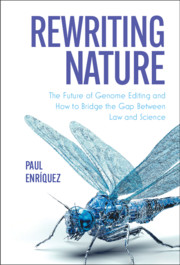Book contents
- Rewriting Nature
- Rewriting Nature
- Copyright page
- Dedication
- Summary of Contents
- Contents
- Figures
- Foreword
- Acknowledgments
- Table of Cases
- Abbreviations
- 1 A Momentous Time for Humankind
- 2 How an Idea Became a Reality
- 3 What Is Genome Editing?
- 4 Molecular Paraphernalia
- 5 What Can Genome Editing Be Used for?
- 6 Redesigning Food
- 7 Regulating Bioengineered Food
- 8 Redesigning Humanity
- 9 DNA and the Administrative State
- 10 Constitutional Predicaments
- 11 Science, Law, and Policy
- 12 Epilogue
- Index
2 - How an Idea Became a Reality
Published online by Cambridge University Press: 11 June 2021
- Rewriting Nature
- Rewriting Nature
- Copyright page
- Dedication
- Summary of Contents
- Contents
- Figures
- Foreword
- Acknowledgments
- Table of Cases
- Abbreviations
- 1 A Momentous Time for Humankind
- 2 How an Idea Became a Reality
- 3 What Is Genome Editing?
- 4 Molecular Paraphernalia
- 5 What Can Genome Editing Be Used for?
- 6 Redesigning Food
- 7 Regulating Bioengineered Food
- 8 Redesigning Humanity
- 9 DNA and the Administrative State
- 10 Constitutional Predicaments
- 11 Science, Law, and Policy
- 12 Epilogue
- Index
Summary
Scientists have long recognized the value of developing methods to induce modifications in DNA sequences. Although the wave of recent breakthroughs concerning gene editing has propelled the field to the forefront of science, the concept itself is not new. This chapter explains how genome editing became a reality and argues that the concept of genetic manipulation is rooted in popular culture. The chapter begins by introducing readers to Gregor Mendel’s groundbreaking pea-plant experiments in the mid-1800s, which gave rise to modern genetics. The chapter then provides a concise overview of the origins of the concept of genetic manipulation, and how the discovery of two critical elements—restriction enzymes and DNA-repair mechanisms—in the second half of the twentieth century marked the genesis of modern molecular biology and biotechnology. Importantly, this chapter acquaints readers with fundamental concepts in molecular biology and genetics—including gene expression, DNA replication, RNA transcription, protein translation, DNA repair, the structure of DNA, the rise of genetic mutations, the flow of genetic information through the central dogma of molecular biology, and more—and explains important scientific terminology in a clear and accessible format with the aid of illustrations.
Keywords
- Type
- Chapter
- Information
- Rewriting NatureThe Future of Genome Editing and How to Bridge the Gap Between Law and Science, pp. 32 - 68Publisher: Cambridge University PressPrint publication year: 2021



